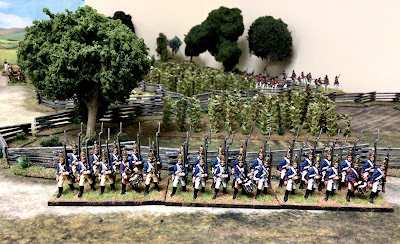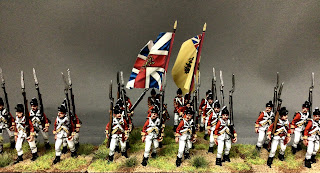 |
| Fife and Drum Miniature Hessian Musketeers wore uniforms that were similar to those of the Brunswick soldiers. |
Part II of the Guide to the Saratoga Project describes the organization and uniforms of the German troops that were in Burgoyne's Canada Army.
Burgoyne's army consisted of about 4,400 British troops and 4,700 German troops at the start of his campaign. The German contingent was comprised largely of hired soldiers from the Duchy of Brunswick in Germany. There was also a smaller German contigent from Hesse Hanau. The Duke of Brunswick's son, Carl Wilhelm Ferdinand, was married to George III of Britain's older sister. This facilitated the rental of Brunswick regiments to the British cause in North America.
The Hesse Hanau musketeer regiment, including its grenadier company, was stationed at Fort Ticonderoga, and did not participate in the fighting at Saratoga. The von Barner light battalion was composed of musket armed chosen men from the Brunswick musketeer regiments plus one company of rifle armed jagers.
The table below provides information about the uniforms of the Brunswick musketeer regiments. All regiments had blue coats and white small clothes (waist coat and breeches) and white hat lace. The term "Facing Color" refers to the colors of the lapels, collar and cuffs. Hat Lace is simply the color of the tape around the edges of the cocked hat. The pompom was a decorative ball of yarn atop the cocked hat.
Brunswick Musketeer Regiments
Regiments Coat Color Facing Color Buttons Pompoms/center
Prinz Friedrich Blue Yellow White Yellow/White
von Riedesel Blue Yellow White Yellow/White
von Specht Blue Red Yellow Red
von Rhetz Blue White Yellow White/Yellow
Other Regiments
von Barner Blue Black** White White
Jaegers Green Red White Green ***
Hesse Hanau Blue Red * White White
Footnotes
* the Hesse Hanau regiment had red lapels with white button lace
** the light infantry battalion had no lapels; yellow aigulette on the right shoulder
*** the Jagers had green waist coats and buff colored breeches, white aigulette on right shoulder
Regimental Drummers
All musicians wore a yellow coat with shoulder epaulettes in white. There were no chevrons on the sleeves save that of the senior drummer in the regiment. The facing colors varied from regiment to regiment, as follows:
Light Blue - Prinz Friedrich and von Riedesel
Red - von Specht
White - von Hetz
Coat Details
Uniform coats were dark blue with red turn backs. The cuffs were of the looser Swedish Cuff style rather than the tight Prussian cuff. The lapels had only four buttons: one on the top, then a pair of buttons in the middle of the lapel, and one button on the bottom of the lapel.
Small Clothes
All regiments wore white waistcoats and white breeches. The Brunswickers adapted the British style of "overalls". The overall was a single leg with gaitor buttons at the ankles near the bottom of the cloth, thereby negating the need for the soldiers to wear separate leg gaitors. There is some conjecture that the Brunswick soldiers wore stripped overalls made from mattress ticking. This is incorrect as the overalls were made from the linen colored spare tents provided by the British. The striped overall look originates from the John Mollo book on uniforms of the American Revolution and the error has perpetuated itself into many a uniform plate. The only Brunswick soldiers that wore striped ticking overalls were the Prinz Ludwig dismounted dragoon regiment.
Officers
Brunswick officers were armed with sword and carried spontoons. There is some speculation that the pole arms for officers and NCOs were left in storage in Canada and that they carried firearms. Officers were distinguished by a waist sash of a silver and yellow mix as well as with a gorget around their necks. Their hats hat silver lace and a black cockade on the front.
Brunswick NCOs were distinguished by an ash cane that hung from the second button from the top on the righthand lapel. They had metalic lace on the collar, lapels and cuffs. Their cocked hats had black and white pompoms and hat tightener cords. Those NCOs carrying firearms wore a belly box for cartridges on their front waist.
Grenadiers
Brunswick grenadiers wore the same uniform as the musketeers in the regiment, save for the ubiquitous miter hat. The grenadier company from each of the four Brunswick regiments were converged into one grenadier battalion.
 |
| Hessian Grenadiers from Fife & Drum Miniatures- uniforms were similar to those of Brunswick grenadiers. |
Grenadier Miters
Miter Plate Miter Bag Pompom
Prinz Friedrich Silver Yellow w/white piping Yellow/white
von Riedesel Silver Yellow w/white piping Yellow/white
von Specht Brass Red w/white piping White
von Rhetz Brass White w/ red piping Red
Hesse Hanau Silver Yellow w/white piping Red /yellow
 |
| Hessian Grenadiers from Fife and Drum Miniatures. Their uniforms are similar to those of Brunswick grenadiers. |
Fife and Drum Miniatures is currently working on Brunswick musketeers and grenadiers to be added to the product range. Their expected arrival is approximately late April 2021. In the meantime, I use the F&D Hessian figures as stand ins for Brunswickers. The principal difference between Brunswickers and Hessians is that the former wear one-piece overalls and the latter wear gaitors.









